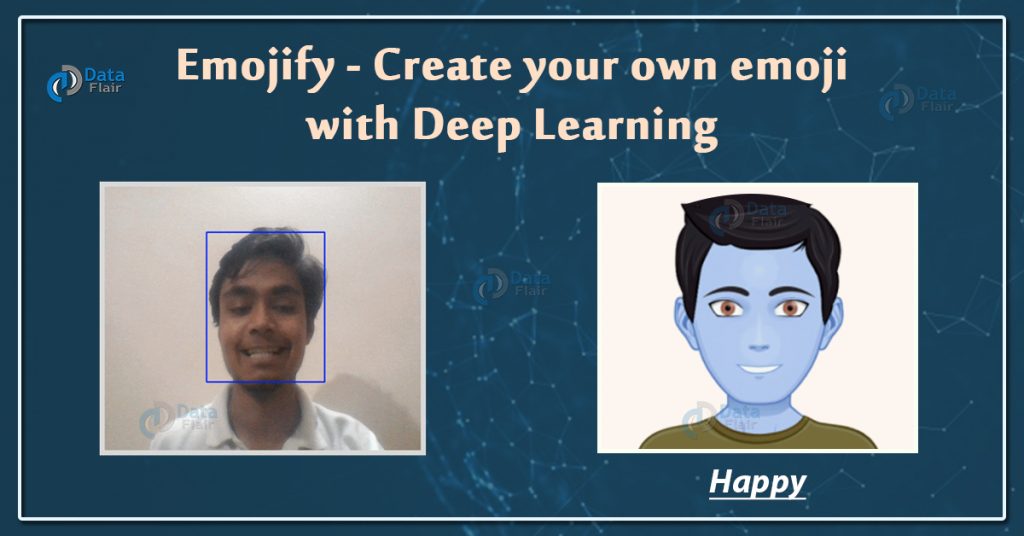Free Machine Learning courses with 130+ real-time projects Start Now!!
Deep Learning project for beginners – Taking you closer to your Data Science dream
Emojis or avatars are ways to indicate nonverbal cues. These cues have become an essential part of online chatting, product review, brand emotion, and many more. It also lead to increasing data science research dedicated to emoji-driven storytelling.
With advancements in computer vision and deep learning, it is now possible to detect human emotions from images. In this deep learning project, we will classify human facial expressions to filter and map corresponding emojis or avatars.
About the Dataset
The FER2013 dataset ( facial expression recognition) consists of 48*48 pixel grayscale face images. The images are centered and occupy an equal amount of space. This dataset consist of facial emotions of following categories:
- 0:angry
- 1:disgust
- 2:feat
- 3:happy
- 4:sad
- 5:surprise
- 6:natural
Download Dataset: Facial Expression Recognition Dataset
Download Project Code
Before proceeding ahead, please download the source code: Emoji Creator Project Source Code
Create your emoji with Deep Learning
We will build a deep learning model to classify facial expressions from the images. Then we will map the classified emotion to an emoji or an avatar.
Facial Emotion Recognition using CNN
In the below steps will build a convolution neural network architecture and train the model on FER2013 dataset for Emotion recognition from images.
Technology is evolving rapidly!
Stay updated with DataFlair on WhatsApp!!
Download the dataset from the above link. Extract it in the data folder with separate train and test directories.
Make a file train.py and follow the steps:
1. Imports:
import numpy as np import cv2 from keras.emotion_models import Sequential from keras.layers import Dense, Dropout, Flatten from keras.layers import Conv2D from keras.optimizers import Adam from keras.layers import MaxPooling2D from keras.preprocessing.image import ImageDataGenerator
2. Initialize the training and validation generators:
train_dir = 'data/train'
val_dir = 'data/test'
train_datagen = ImageDataGenerator(rescale=1./255)
val_datagen = ImageDataGenerator(rescale=1./255)
train_generator = train_datagen.flow_from_directory(
train_dir,
target_size=(48,48),
batch_size=64,
color_mode="gray_framescale",
class_mode='categorical')
validation_generator = val_datagen.flow_from_directory(
val_dir,
target_size=(48,48),
batch_size=64,
color_mode="gray_framescale",
class_mode='categorical')
3. Build the convolution network architecture:
emotion_model = Sequential() emotion_model.add(Conv2D(32, kernel_size=(3, 3), activation='relu', input_shape=(48,48,1))) emotion_model.add(Conv2D(64, kernel_size=(3, 3), activation='relu')) emotion_model.add(MaxPooling2D(pool_size=(2, 2))) emotion_model.add(Dropout(0.25)) emotion_model.add(Conv2D(128, kernel_size=(3, 3), activation='relu')) emotion_model.add(MaxPooling2D(pool_size=(2, 2))) emotion_model.add(Conv2D(128, kernel_size=(3, 3), activation='relu')) emotion_model.add(MaxPooling2D(pool_size=(2, 2))) emotion_model.add(Dropout(0.25)) emotion_model.add(Flatten()) emotion_model.add(Dense(1024, activation='relu')) emotion_model.add(Dropout(0.5)) emotion_model.add(Dense(7, activation='softmax'))
4. Compile and train the model:
emotion_model.compile(loss='categorical_crossentropy',optimizer=Adam(lr=0.0001, decay=1e-6),metrics=['accuracy'])
emotion_model_info = emotion_model.fit_generator(
train_generator,
steps_per_epoch=28709 // 64,
epochs=50,
validation_data=validation_generator,
validation_steps=7178 // 64)
5. Save the model weights:
emotion_model.save_weights('model.h5')
6. Using openCV haarcascade xml detect the bounding boxes of face in the webcam and predict the emotions:
cv2.ocl.setUseOpenCL(False)
emotion_dict = {0: "Angry", 1: "Disgusted", 2: "Fearful", 3: "Happy", 4: "Neutral", 5: "Sad", 6: "Surprised"}
cap = cv2.VideoCapture(0)
while True:
ret, frame = cap.read()
if not ret:
break
bounding_box = cv2.CascadeClassifier('/home/shivam/.local/lib/python3.6/site-packages/cv2/data/haarcascade_frontalface_default.xml')
gray_frame = cv2.cvtColor(frame, cv2.COLOR_BGR2gray_frame)
num_faces = bounding_box.detectMultiScale(gray_frame,scaleFactor=1.3, minNeighbors=5)
for (x, y, w, h) in num_faces:
cv2.rectangle(frame, (x, y-50), (x+w, y+h+10), (255, 0, 0), 2)
roi_gray_frame = gray_frame[y:y + h, x:x + w]
cropped_img = np.expand_dims(np.expand_dims(cv2.resize(roi_gray_frame, (48, 48)), -1), 0)
emotion_prediction = emotion_model.predict(cropped_img)
maxindex = int(np.argmax(emotion_prediction))
cv2.putText(frame, emotion_dict[maxindex], (x+20, y-60), cv2.FONT_HERSHEY_SIMPLEX, 1, (255, 255, 255), 2, cv2.LINE_AA)
cv2.imshow('Video', cv2.resize(frame,(1200,860),interpolation = cv2.INTER_CUBIC))
if cv2.waitKey(1) & 0xFF == ord('q'):
cap.release()
cv2.destroyAllWindows()
break
Code for GUI and mapping with emojis
Create a folder named emojis and save the emojis corresponding to each of the seven emotions in the dataset.
Paste the below code in gui.py and run the file.
import tkinter as tk
from tkinter import *
import cv2
from PIL import Image, ImageTk
import os
import numpy as np
import cv2
from keras.models import Sequential
from keras.layers import Dense, Dropout, Flatten
from keras.layers import Conv2D
from keras.optimizers import Adam
from keras.layers import MaxPooling2D
from keras.preprocessing.image import ImageDataGenerator
emotion_model = Sequential()
emotion_model.add(Conv2D(32, kernel_size=(3, 3), activation='relu', input_shape=(48,48,1)))
emotion_model.add(Conv2D(64, kernel_size=(3, 3), activation='relu'))
emotion_model.add(MaxPooling2D(pool_size=(2, 2)))
emotion_model.add(Dropout(0.25))
emotion_model.add(Conv2D(128, kernel_size=(3, 3), activation='relu'))
emotion_model.add(MaxPooling2D(pool_size=(2, 2)))
emotion_model.add(Conv2D(128, kernel_size=(3, 3), activation='relu'))
emotion_model.add(MaxPooling2D(pool_size=(2, 2)))
emotion_model.add(Dropout(0.25))
emotion_model.add(Flatten())
emotion_model.add(Dense(1024, activation='relu'))
emotion_model.add(Dropout(0.5))
emotion_model.add(Dense(7, activation='softmax'))
emotion_model.load_weights('model.h5')
cv2.ocl.setUseOpenCL(False)
emotion_dict = {0: " Angry ", 1: "Disgusted", 2: " Fearful ", 3: " Happy ", 4: " Neutral ", 5: " Sad ", 6: "Surprised"}
emoji_dist={0:"./emojis/angry.png",2:"./emojis/disgusted.png",2:"./emojis/fearful.png",3:"./emojis/happy.png",4:"./emojis/neutral.png",5:"./emojis/sad.png",6:"./emojis/surpriced.png"}
global last_frame1
last_frame1 = np.zeros((480, 640, 3), dtype=np.uint8)
global cap1
show_text=[0]
def show_vid():
cap1 = cv2.VideoCapture(0)
if not cap1.isOpened():
print("cant open the camera1")
flag1, frame1 = cap1.read()
frame1 = cv2.resize(frame1,(600,500))
bounding_box = cv2.CascadeClassifier('/home/shivam/.local/lib/python3.6/site-packages/cv2/data/haarcascade_frontalface_default.xml')
gray_frame = cv2.cvtColor(frame1, cv2.COLOR_BGR2GRAY)
num_faces = bounding_box.detectMultiScale(gray_frame,scaleFactor=1.3, minNeighbors=5)
for (x, y, w, h) in num_faces:
cv2.rectangle(frame1, (x, y-50), (x+w, y+h+10), (255, 0, 0), 2)
roi_gray_frame = gray_frame[y:y + h, x:x + w]
cropped_img = np.expand_dims(np.expand_dims(cv2.resize(roi_gray_frame, (48, 48)), -1), 0)
prediction = emotion_model.predict(cropped_img)
maxindex = int(np.argmax(prediction))
cv2.putText(frame1, emotion_dict[maxindex], (x+20, y-60), cv2.FONT_HERSHEY_SIMPLEX, 1, (255, 255, 255), 2, cv2.LINE_AA)
show_text[0]=maxindex
if flag1 is None:
print ("Major error!")
elif flag1:
global last_frame1
last_frame1 = frame1.copy()
pic = cv2.cvtColor(last_frame1, cv2.COLOR_BGR2RGB)
img = Image.fromarray(pic)
imgtk = ImageTk.PhotoImage(image=img)
lmain.imgtk = imgtk
lmain.configure(image=imgtk)
lmain.after(10, show_vid)
if cv2.waitKey(1) & 0xFF == ord('q'):
exit()
def show_vid2():
frame2=cv2.imread(emoji_dist[show_text[0]])
pic2=cv2.cvtColor(frame2,cv2.COLOR_BGR2RGB)
img2=Image.fromarray(frame2)
imgtk2=ImageTk.PhotoImage(image=img2)
lmain2.imgtk2=imgtk2
lmain3.configure(text=emotion_dict[show_text[0]],font=('arial',45,'bold'))
lmain2.configure(image=imgtk2)
lmain2.after(10, show_vid2)
if __name__ == '__main__':
root=tk.Tk()
img = ImageTk.PhotoImage(Image.open("logo.png"))
heading = Label(root,image=img,bg='black')
heading.pack()
heading2=Label(root,text="Photo to Emoji",pady=20, font=('arial',45,'bold'),bg='black',fg='#CDCDCD')
heading2.pack()
lmain = tk.Label(master=root,padx=50,bd=10)
lmain2 = tk.Label(master=root,bd=10)
lmain3=tk.Label(master=root,bd=10,fg="#CDCDCD",bg='black')
lmain.pack(side=LEFT)
lmain.place(x=50,y=250)
lmain3.pack()
lmain3.place(x=960,y=250)
lmain2.pack(side=RIGHT)
lmain2.place(x=900,y=350)
root.title("Photo To Emoji")
root.geometry("1400x900+100+10")
root['bg']='black'
exitbutton = Button(root, text='Quit',fg="red",command=root.destroy,font=('arial',25,'bold')).pack(side = BOTTOM)
show_vid()
show_vid2()
root.mainloop()
Summary
In this deep learning project for beginners, we have built a convolution neural network to recognize facial emotions. We have trained our model on the FER2013 dataset. Then we are mapping those emotions with the corresponding emojis or avatars.
Using OpenCV’s haar cascade xml we are getting the bounding box of the faces in the webcam. Then we feed these boxes to the trained model for classification.
DataFlair is committed to provide all the resources to make you a data scientist, which includes detailed tutorials, practicals, use-cases as well as projects with source code.
